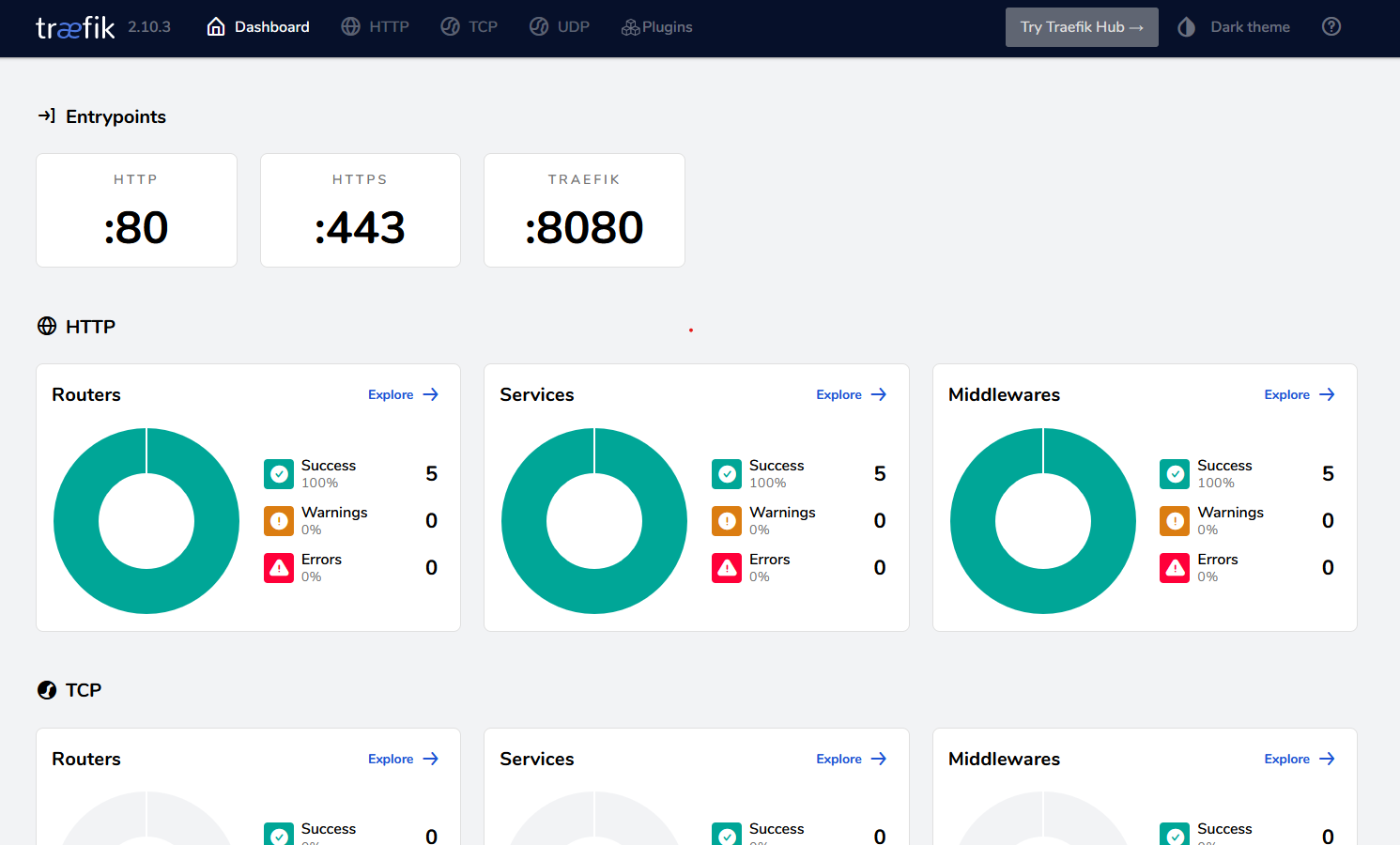Traefik - Load Balancing and Reverse Proxy
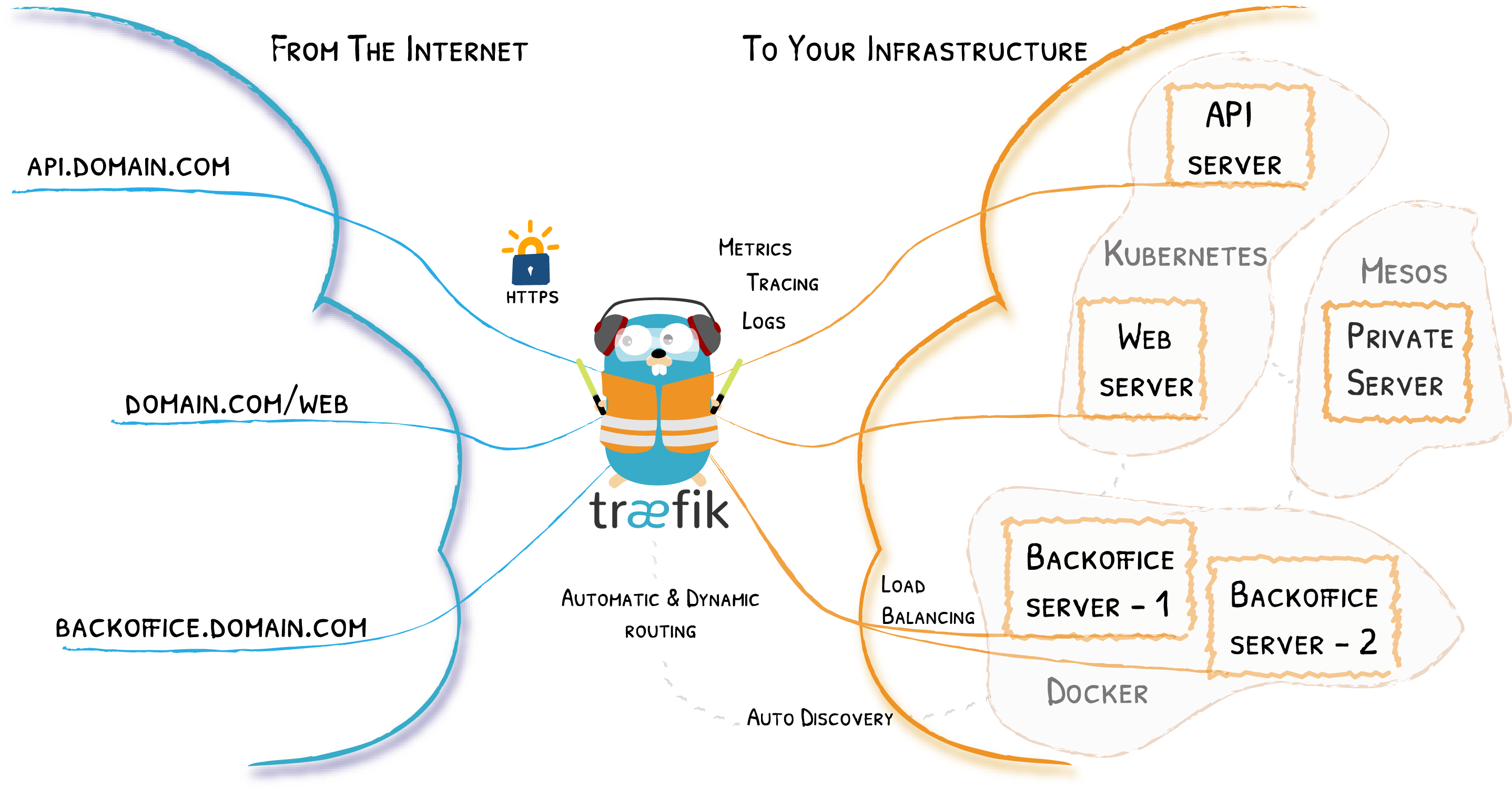 This blog will set up a simple reverse proxy and load balancing with traefik. Traefik is good for containerize environment. We can use a label in
This blog will set up a simple reverse proxy and load balancing with traefik. Traefik is good for containerize environment. We can use a label in docker-compose.yml for config.
Prerequisite
- DockerCompose
- set up your domain name record in your dns / bind it in /etc/hosts
Installation
create a docker-compose.yml
1
2
3
4
5
6
7
8
9
10
11
12
13
14
15
16
17
18
19
20
21
22
23
24
version: "3.8"
services:
traefik:
image: traefik:latest
ports:
- 80:80
- 443:443
- 8080:8080
networks:
- proxy
volumes:
- /etc/localtime:/etc/localtime:ro
- /var/run/docker.sock:/var/run/docker.sock:ro
- ./data/traefik.yml:/traefik.yml:ro
labels:
- "traefik.enable=true"
- "traefik.http.routers.traefik.entrypoints=http"
- "traefik.http.routers.traefik.rule=Host(`traefik.techcat.local`)"
networks:
proxy:
external: true
create a ./data/traefik.yml
1
2
3
4
5
6
7
8
9
10
11
12
13
14
api:
dashboard: true
insecure: true
entryPoints:
http:
address: ":80"
https:
address: ":443"
providers:
docker:
endpoint: "unix:///var/run/docker.sock"
exposedByDefault: false
Dashboard
Demo
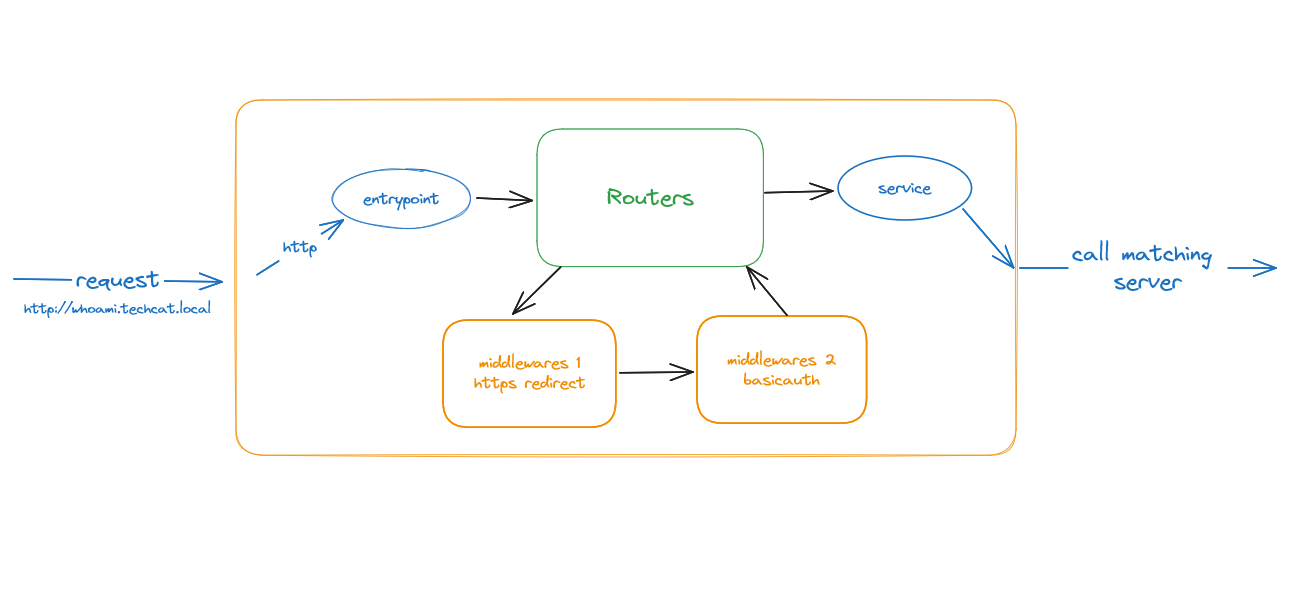 go back
go back docker-compose.yml file, add whoami container
whoami default is using 80 port for web server, so no need to use load balancing in traefik.
1
2
3
4
5
6
7
8
9
10
...
whoami:
image: "traefik/whoami"
labels:
- "traefik.enable=true"
- "traefik.http.routers.whoami.rule=Host(`whoami.techcat.local`)"
- "traefik.http.routers.whoami.entrypoints=http"
...
go http://whoami.techcat.local 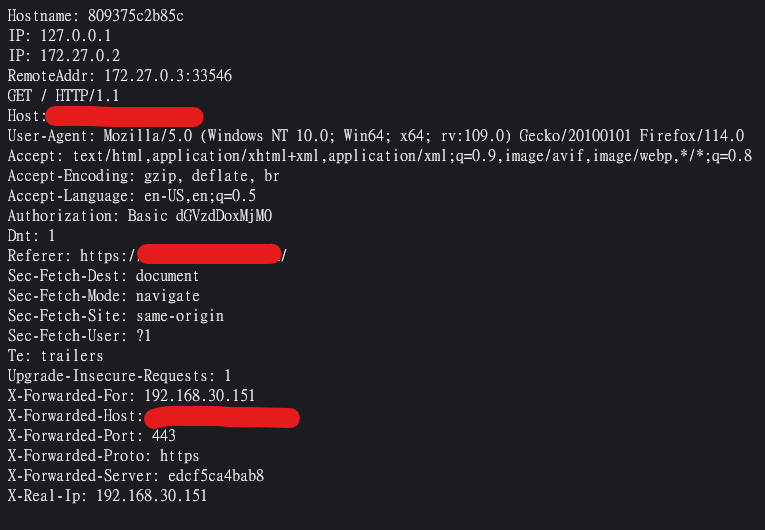
Middleware
We can add a middleware for add prefix, redirect and basic auth.
reference: https://doc.traefik.io/traefik/middlewares/http/overview/
I use basic auth for example.
docker-compose.yml
1
2
3
4
5
6
7
8
9
10
11
12
13
14
15
16
17
18
19
traefik:
volumes:
- /etc/localtime:/etc/localtime:ro
- /var/run/docker.sock:/var/run/docker.sock:ro
- ./data/traefik.yml:/traefik.yml:ro
- ./data/usersfile:/usersfile:ro
...
whoami:
image: "traefik/whoami"
labels:
- "traefik.enable=true"
- "traefik.http.routers.whoami.rule=Host(`whoami.techcat.local`)"
- "traefik.http.routers.whoami.entrypoints=http"
- "traefik.http.routers.whoami-secure.middlewares=test-auth"
- "traefik.http.middlewares.test-auth.basicauth.usersfile=/usersfile"
...
create a usersfile, use htpasswd to generate your id & password
or go https://hostingcanada.org/htpasswd-generator/ to generate it.
./data/usersfile
1
test:$2y$10$FPU6eAgBlmAsH6gXC3DTguyW6uK0J8ID7UteimxZLqGGyDSfq8T/W
reload your traefik docker-compose
1
docker-compose up -d --force-recreate
Now go http://whoami.techcat.local, you will get the login popup.
Listen Host & Path
1
2
3
4
5
6
7
8
9
10
11
12
13
14
15
16
17
18
19
20
21
22
23
24
25
26
27
28
29
version: "3.8"
services:
traefik:
image: "traefik:latest"
ports:
- "80:80"
- "8089:8080"
- "443:443"
volumes:
- "/var/run/docker.sock:/var/run/docker.sock:ro"
- "./data/traefik.yml:/traefik.yml:ro"
- "./usersfile:/usersfile:ro"
whoami:
image: "traefik/whoami"
labels:
# http section
- "traefik.enable=true"
- "traefik.http.routers.whoami.rule=Host(`whoami.techcat.local`)"
- "traefik.http.routers.whoami.entrypoints=http"
whoami2:
image: "nginxdemos/hello"
deploy:
replicas: 1
labels:
- "traefik.enable=true"
- "traefik.http.routers.whoami2.rule=Host(`whoami.techcat.local`) && Path(`/whoami2`)"
- "traefik.http.routers.whoami2.entrypoints=http"
1
docker-compose up -d
Now go http://whoami.techcat.local/whoami2 will see below
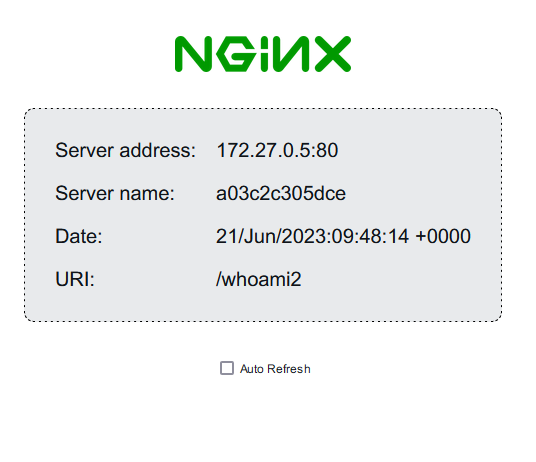
TLS
Now add a https section into whoami label.
enable tls and set the true.
1
2
3
4
5
6
7
8
9
10
11
12
13
14
15
...
whoami:
image: "traefik/whoami"
labels:
# http section
- "traefik.enable=true"
- "traefik.http.routers.whoami.rule=Host(`whoami.techcat.local`)"
- "traefik.http.routers.whoami.entrypoints=http"
# https section
- "traefik.http.routers.whoami-secure.rule=Host(`whoami.techcat.local`)"
- "traefik.http.routers.whoami-secure.entrypoints=https"
- "traefik.http.routers.whoami-secure.tls=true"
...
Dynamic config
Define TLS certificate add into data/dynamic-config.yml
docs: https://doc.traefik.io/traefik/https/tls/
1
2
3
4
tls:
certificates:
certFile = "/certs/cert.crt"
keyFile = "/certs/cert.key"
map a cert and dynamic-config.yml volume into docker-compose.yml
1
2
3
4
5
6
7
8
...
volumes:
- "/var/run/docker.sock:/var/run/docker.sock:ro"
- "./data/traefik.yml:/traefik.yml:ro"
- "./data/dynamic-config.yml:/dynamic-config.yml:ro"
- "./certs:/certs"
...
docker-compose.yml
1
2
3
4
5
6
7
8
9
10
11
12
13
14
15
16
17
18
19
20
21
22
23
24
25
26
27
28
29
30
31
32
33
version: "3.8"
services:
traefik:
image: "traefik:latest"
ports:
- "80:80"
- "8080:8080"
- "443:443"
volumes:
- "/var/run/docker.sock:/var/run/docker.sock:ro"
- "./data/traefik.yml:/traefik.yml:ro"
- "./data/dynamic-config.yml:/dynamic-config.yml:ro"
- "./certs:/certs"
- "./usersfile:/usersfile:ro"
whoami:
image: "traefik/whoami"
labels:
- "traefik.enable=true"
# http section
- "traefik.http.routers.whoami.rule=Host(`whoami.techcat.local`)"
- "traefik.http.routers.whoami.entrypoints=http"
- "traefik.http.routers.whoami.middlewares=https-redirect"
- "traefik.http.middlewares.https-redirect.redirectscheme.scheme=https"
# https section
- "traefik.http.routers.whoami-secure.rule=Host(`whoami.techcat.local`)"
- "traefik.http.routers.whoami-secure.entrypoints=https"
- "traefik.http.routers.whoami-secure.tls=true"
- "traefik.http.routers.whoami-secure.middlewares=test-auth"
- "traefik.http.middlewares.test-auth.basicauth.usersfile=/usersfile"
